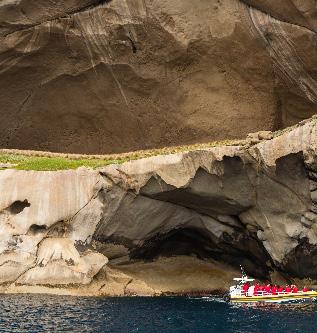
3 minute read
Visit the mysterious Skull Rock
Fewer people have set foot on Skull Island, just off Wilsons Promontory in Gippsland, than have stood on the moon – and when you get close to this natural wonder you realise why. The sheer cliffs are impenetrable – save for a few crevices that only the foolhardy would attempt to assail – but they are also beautiful, a sandcoloured Rorschach test where visitors see skulls, parts of ships and even fish backbones in the contours of the windswept granite.
We bob about in front of the huge crevice and pick out shapes in the rock and we learn that one of the few expeditions to make it inside this giant cleft discovered a rusting cannon ball thought to be from the First Fleet.
Skull Rock can be seen from the beaches of “the Prom” but for the first time this year you can get a much closer look on an eco-tour with Pennicott Wilderness Journeys who have been running boat tours in Tasmania for decades.
“Every time I cross Bass Strait to Skull Rock I think that this is just off the planet, it’s beautiful,” says Rob Pennicott. “I don’t do things unless my heart is in it and this one my heart was right into. But we are just one product; the Gippsland region has got lots of great activities and accommodation.”
Rob is the unpretentious boss of Pennicott Wilderness Journeys, and he is underplaying the effort and investment in becoming the first-ever boat tour to operate out of Wilsons Promontory. To keep the impact to a minimum Rob could not have a wharf, so instead put money into three of the largest amphibious vehicles in the world, with a price tag of over a million dollars each. The whole endeavour took 11 years. The boats are fast and comfortable and we board on the sand before driving off into the crashing waves, Rob is at the wheel and he is as adept with a fact or a dad joke as he is with piloting his million-dollar aquatic baby.
A journey like no other deserves a vessel to match...

Cologne De Seal
The eco tour starts by skirting the rugged coastline of the Prom where we encounter pods of dolphins racing alongside the boat and gannets and shearwaters plunging into the choppy waters in search of fish. Rob spots the tangled branches of a white-bellied sea eagle on the peak of a granite outcrop before he warns us, we are about to head off to an islet that will smell pretty strongly of “cologne de seal”. The boat veers away from the coast and out in to the less-forgiving waters of Bass Strait where we encounter Rodondo Island, the first lump of granite that signals the start of Tasmania. According to Rob, Rodondo often has its own cloud that likes to hang around the peak of the island giving it the look of a giant smokestack. Then we round another island that is home to over 9,000 Australian fur seals – and with it comes the famous cologne, a pungent mix of seaspray and seal poo.
We stop the boat near a smaller island with seals that slip down the rock and into the water. They swim toward us, eyeing us curiously. Then we skip easily across the waves of the strait to our final destination of Skull Island.
Cameras are out all over the boat, trying to capture the huge crevice with its curious lip of bright-green grass, but you can’t beat the feeling of being just a few metres away from such a mysterious lump of granite; a natural mystery that few have climbed but now many can experience of the safety of these new boats.
For more information and to book a cruise visit Pennicott Wilderness Journeys.









